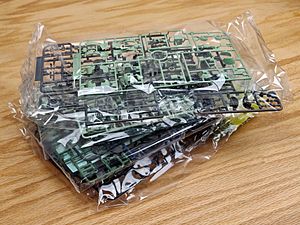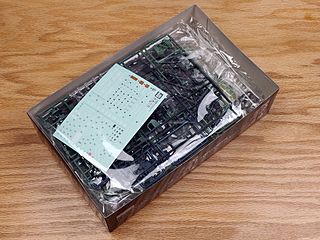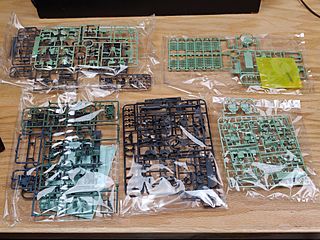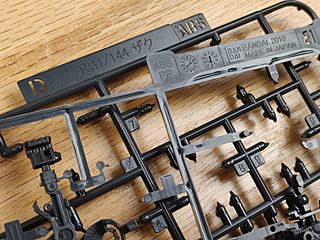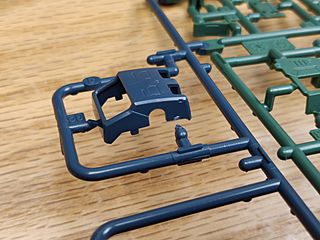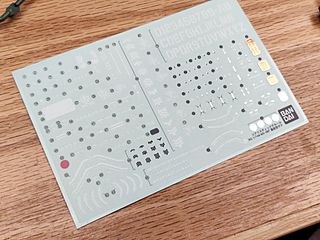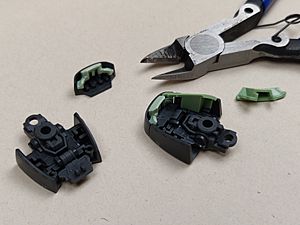Gunpla facts for kids
 |
|
| Type | Scaled model kits |
|---|---|
| Inventor(s) | Yoshiyuki Tomino |
| Company | Bandai (1980-2017) Bandai Spirits (2017-present) |
| Country | Japan |
| Availability | 1980–present |
| Materials | Plastic |
Gunpla (short for Gundam plastic model) are cool model kits. They let you build miniature versions of the giant robots and characters from the Gundam universe. These kits are made by Bandai Spirits.
Gunpla became super popular in Japan and other Asian countries in the 1980s. Fans of robot anime and model building loved them. In the 1990s, Gundam shows and comics reached North America and Europe. This helped Gunpla become popular worldwide.
The name "Gunpla" comes from combining "Gundam" and "plastic model." This is because most kits are made of plastic.
Bandai has sold a huge number of Gunpla kits. Between 1980 and 1984, they sold over 100 million kits. By May 1999, this number grew to over 300 million. As of March 2021, Bandai Namco sold over 714 million Gunpla kits globally. This includes over 538 million standard Gundam units and 176 million SD Gundam units. There are nearly 2,000 different Gundam models available.
Contents
- The Story of Gunpla
- Building Your Gunpla
- How Gunpla Are Designed
- What Gunpla Are Made Of
- Gunpla Sizes (Scale)
- Gunpla Grades
- The Gunpla Hobby
- Gunpla Model Series
- Gundam FIX Figuration
- Special Editions
- Huge Display Models
- See also
The Story of Gunpla
How Gunpla Started (1970s–1980s)
Gunpla models are based on the Mobile Suit Gundam TV show. This show first aired in 1979. At first, the show and its toys were not very successful.
In 1980, Bandai got the rights to make Gundam models. Unlike earlier toys that came fully built, Bandai designed their models as plastic kits. You had to put them together yourself. This idea was a big hit with teenagers and adults who watched Mobile Suit Gundam.
Soon, almost every robot and vehicle from the show became a model kit. The parts came in different colors, so you didn't have to paint everything. Early kits needed glue to be put together. They also had less movement and detail than today's kits.
Later, Bandai invented "System Injection." This cool method allowed them to make a single part with multiple plastic colors at once. This made painting even less necessary.
Growing Up: New Features (1980s–1990s)
In 1985, Bandai started using "poly-caps." These are soft plastic connectors that made the model's joints move much better.
By 1987, Bandai introduced "snap-fit" models. These kits didn't need any glue to assemble! This became the standard by 1988, making building Gunpla even easier.
In 1990, Bandai launched the High Grade (HG) line. This was the start of making models with much better quality. HG kits had amazing detail and movement, even at a smaller 1:144 scale. For example, some could transform or had removable pilot sections.
By 1993, Bandai made a standard set of poly-cap joints for smaller models. This helped them make many new models faster. Because of this, Gundam shows in the 1990s often had many 1:144 scale models.
The Master Grade (MG) line came out in 1995. These 1:100 scale kits had more parts, better detail, and even more movement.
In 1998, the Perfect Grade (PG) line was introduced. These 1:60 scale kits are the most detailed and expensive. They often have light-up features and a full "skeleton" frame inside. You attach the outer armor panels to this frame.
To celebrate the 20th anniversary of Gundam in 1999, Bandai released First Grade (FG) kits. These 1:144 scale models were simple and affordable. They were easy to snap together, like the original kits, but with updated designs.
Modern Gunpla (2000s–2010s)
In the 2000s, Bandai started using the term "Gunpla" more often. They also introduced new types of models. For example, some 1:144 scale models for Mobile Suit Gundam SEED were "non-graded" (NG). These were budget-friendly and had limited movement.
In 2010, for Gundam's 30th anniversary, Bandai released the 1:48 Mega Size Model RX-78-2 Gundam. These huge kits were designed to be super easy for beginners to build. You could even break parts off the plastic frames without special tools.
The same year, Bandai launched the 1:144 Real Grade (RG) line. These kits combine the detailed inner frames of MG models with the smaller HG scale. They look very realistic.
Bandai also released "Ecopla" kits made from recycled plastic. In 2011, the Entry Grade (EG) line started. These were low-cost models, first made in China. The EG line was rebooted in 2020 with new kits that are even easier to build.
In 2017, Bandai started the Gundam Evolution Project. This project aimed to make Gunpla technology even better. They worked on new joint systems and LED lights for large kits. This was all to get ready for Gunpla's 40th anniversary in 2020.
Building Your Gunpla
Gunpla kits come in many types, but most plastic kits made since the late 1980s are built in a similar way. Each kit includes plastic parts, decals, and sometimes other cool accessories. You put these together by hand to create your finished model.
The plastic parts come attached to a "sprue tree." This is a frame of plastic rods. Each part is connected to the frame by a small plastic nub called a "gate."
To start, you cut each part away from the sprue. You can use special side cutting pliers for this. Then, you can trim or sand away any leftover plastic from where the gate was. This makes the surface smooth and clean.
Once the parts are free, you snap them together to build the model. Older kits needed glue, but since the late 1980s, all kits snap together without special tools or glue.
Some advanced kits have an "internal frame." This is like a complete skeleton that can stand on its own. You then attach the outer armor panels to this frame to finish the robot's look.
Making It Your Own: Customization
After assembling the main parts, you can customize your model in many ways. The simplest way is to paint it. This lets you add your own creative touch. Applying decals is also common. Most models come with decals, but you can buy extra ones too.
There are many ways to make your Gunpla unique:
- Panel lining: Many models have small grooves that look like panel lines. You can use a fine pen or brush to fill these lines with paint or ink. This makes the details stand out.
- Weathering: You can use paint or carving tools to make your model look old, worn, or battle-damaged. This makes it seem like a real robot that has been in action.
- Kitbashing: This means combining parts from different kits to create a brand-new, unique model. It's like building your own custom robot!
- Conversion kits: These are extra parts, often made by other companies, that you can add to an official Bandai model. They can change your model into a different version of the robot.
- Custom parts: If you're really skilled, you can even create your own parts from scratch. These can add more detail, improve movement, or give your model new features.
All these steps are optional. You can still build and display a great model using just side-cutters.
Most assembled models can be posed in different ways. Many are "fully poseable," meaning they can move a lot. To help models stay in cool action poses, you can put them on a display stand. Many newer models have a special spot for this.
- Gunpla kit assembly
How Gunpla Are Designed
Over the years, Gunpla models have changed a lot. They range from simple models that don't move much to highly detailed ones. These advanced models can be posed in many ways and have interchangeable parts like weapons and shields.
All Gunpla parts fit together without glue or special tools. They use different types of joints, like ball-and-socket joints. While models are made for display, their joints are not designed for rough play like action figures. Parts might come loose if you move them too much.
Bandai uses different plastic materials for different parts. For example, a foot or leg might use parts made from several types of plastic. Bandai also adds color to each part during manufacturing. This means you don't have to paint the model if you don't want to.
The picture above shows the amazing detail of a Real Grade model from 2011. This small foot part, less than an inch across, has many tiny details. It's even built around a tiny double-jointed hinge. The full leg unit uses many more parts. It can bend at two main joints, and its armor panels even slide apart when the leg bends.
What Gunpla Are Made Of
Gunpla kits can be made from a few different materials.
Plastic Models
Most common Gunpla kits are made from special plastics called thermoplastics. These include ABS, polypropylene, or polystyrene. People usually just call these "plastic" models. They use the snap-fit method, so no glue is needed.
Bandai makes these plastic Gunpla kits in Japan or China. They have the only license to make and sell them worldwide.
Resin Kits
A less common type of model is called a garage kit or resin kit. These are made from a different material called thermoset resin, usually polyurethane. People often just call them "resin" kits. Unlike plastic kits, these need glue to be assembled.
Resin kits were first made by small companies or hobbyists. Bandai also released some official Gundam resin kits under their "B-Club" brand. These models come unpainted and don't have decals. They often need extra work from the builder because of how they are made.
Resin kits are usually more expensive (some cost over $400) and harder to build than plastic kits. However, they offer even more detail for experienced model builders.
Metal Models
A few special kits have also been made from metal. These are offered by different companies. They usually result in a finished model with a similar detail level to a Master Grade kit. These metal models can take several days to build.
Gunpla Sizes (Scale)
Just like models of real-world vehicles, Gunpla models are smaller versions of the robots from the stories. Their "scale" tells you how much smaller they are. For example, 1:60 scale means that every inch of the model's height is equal to 60 inches of the real robot's height.
Generally, finished models are about 4 to 5 inches tall for small scales, 6 to 8 inches for mid-scales, and 12 inches for large scales. Here are some common scales and the types of kits you'll find in them:
| Scale | Grade | Model height (RX-78) |
|---|---|---|
| 1:550 | Various grades | N/A |
| 1:220 | B-Club | 8.2 cm (3.2 in) |
| 1:144 | High Grade, Real Grade, Entry Grade | 12.5 cm (5 in) |
| 1:100 | Master Grade, Master Grade Extreme, Full Mechanics, Reborn-One Hundred | 18 cm (7 in) |
| 1:60 | Perfect Grade, Perfect Grade Unleashed | 30 cm (11.8 in) |
| 1:48 | Mega Size Model | 37.5 cm (14.75 in) |
| 1:35 | UC HardGraph | N/A |
Gunpla Grades
Bandai uses a "grade" system to describe the size and detail of its Gunpla kits. There are four main lines and several other special lines. Each line gets better over time with new technology. So, a High Grade kit from today will be much better than one from 20 years ago. Also, popular robots like the RX-78-2 Gundam are released in many different grades to show off new features.
Gunpla kits are almost never officially stopped from being made.
Original / No Grade / First Grade (FG)
The very first Gundam models from 1980 didn't have a grade name. These kits had limited movement and often needed glue and paint. Kits released with a show or movie that didn't have a grade are called "No Grade" kits. They came in 1/144, 1/100, or 1/60 scales.
In 1999, Bandai re-released some original designs as First Grade (FG) kits. These were simple to build and snap-fit.
Older reissues of the 1980 line are sometimes called the Best Mecha Collection (BMC). In 2024, for Gundam's 45th Anniversary, a modern version of the original RX-78-2 kit was released. It uses modern snap-fit and color separation, but still has limited movement like the original.
High Grade (HG) (1/144)
HG models started in 1990. They were the first to have full snap-fit assembly and often an inner frame for better movement. They also used "System Injection" for multi-colored parts. The High Grade Universal Century (HGUC) line began in 1999, focusing on robots from the Universal Century timeline.
Since 2010, the HG line has expanded to include robots from almost all Gundam series. In 2015, "HG Revive" started. This sub-line updates older HGUC kits with modern detail and movement. HG kits are not just for Gundam; other robot series like Mazinger and Evangelion also have HG kits.
Real Grade (RG) (1/144)
The Real Grade (RG) line was launched in 2010 for Gunpla's 30th anniversary. RG kits are like smaller versions of Master Grades. They have amazing color accuracy, a full inner frame, many parts, and great movement. They also look very "realistic" with extra surface details.
Most RG kits use an "Advanced MS Joint" system. This means the inner frame for the body, arms, and legs comes pre-built and can move. You attach the other parts to it. Newer RG kits use a more stable "Advanced MS Framework."
For Gundam's 45th Anniversary in 2024, a new RX-78-2 Gundam Ver.2.0 RG kit was announced. It focuses on super realistic inner frame details and movement. RG kits also include robots from Neon Genesis Evangelion and The King of Braves Gaogaigar.
Master Grade (MG) (1/100)
MG models first appeared in 1995. These kits are built to a higher standard than most others. They take longer to build and are usually more expensive. Newer Master Grade kits have a movable inner frame. This allows for lots of movement and bending. They also often include tiny figures of the pilots.
Since 2005, older MG kits have been redesigned as "Ver.2.0" with better movement and inner frames. The RX-78-2 Gundam has many MG versions, including ones based on its anime look, a life-size statue, and video games.
The Master Grade line also includes robots from Patlabor and Dunbine. Bandai also made "MG Figure-rise" kits for characters from Dragon Ball Z and Kamen Rider.
Ver. Ka
In 2002, a special line of Master Grade kits called "Ver. Ka" was released. These are redesigned by a famous robot designer named Hajime Katoki. Fans vote each year for which robots get a "Ver. Ka" kit. These kits are known for their realistic designs, complex features, and many decals.
Extreme
Master Grade Extreme (MGEX) started in 2020. These are luxury versions of Master Grades with extra special features called "Extreme Points." For example, the first MGEX kit, the Unicorn Gundam Ver. Ka, had an LED light strip that changed colors. The second, Strike Freedom Gundam, released in November 2022, uses shiny metallic parts for its inner frame.
Perfect Grade (PG) (1/60)
PG is the highest quality line of Bandai kits. The first PG Gunpla kit was a RX-78-2 Gundam model in 1998. Only 19 Gunpla kits have been released as 1/60 Perfect Grade since then.
Perfect Grade kits try to be as "perfect" as possible. They often take several years between releases because Bandai waits for new model-making technology. Perfect Grade Unleashed is an updated PG version. It uses even more advanced tech, like LEDs, metal parts, and a building system that feels like you're building a real robot.
PG kits are known for metal joints, super detailed plastic, opening hatches, and LED lights.
Other Cool Gunpla Lines
Super Deformed (SD)
SD models are not based on a specific scale. They have a funny, "super-deformed" style with very large heads. Super Deformed Gundam kits are usually easy to build and have unique features. However, they have limited movement and often need paint.
The most famous SD line is BB Senshi (BB Warriors), which ran from 1987 to 2018. Other SD lines include:
- SD EX-Standard (2015-): Simple to build, with weapons that can be used with HG kits.
- SD Cross Silhouette (2018-): Uses a simple inner frame for better movement.
- Master Grade SD (2023-): Combines the detail and movement of Master Grades with the SD style.
Entry Grade (EG)
The Entry Grade (EG) line started in 2011 in Southeast Asia. These kits had very few parts and limited movement. Bandai rebooted the EG line in 2020 for worldwide release. The new EG kits, like the RX-78-2 Gundam, have great movement and color separation. They don't need stickers or tools to look good.
Gunpla-Kun
This is a smaller line that began in 2023. These models can be built as a figure or displayed on a fake plastic frame. Gunpla-kun models show off new types of plastic, like limestone-based plastic.
1/100 Full Mechanics
This 1/100 scale line focuses on surface detail and cool "gimmicks" without an inner frame like Master Grades. It started in 2016 and relaunched in 2021 with new robot designs.
Figure Rise Standard
This line makes model kits of characters from anime, manga, and live-action hero shows like Dragon Ball and Ultraman. It also includes human characters from the Gundam series.
Option Parts Set
This 1/144 scale line offers accessories. It re-releases older accessories and creates new ones that fit most modern 1/144 scale kits.
Minipla
Bandai's candy toy division releases Minipla models for combining robots from the Super Sentai series. Each part of the robot is sold in a separate box. "Super Minipla" (now called Shokugan Modeling Project or SMP) are higher-quality versions of these models.
Action Bases
These are display stands that let you pose your Gunpla models in mid-air. Since 2006, 8 types of Action Bases have been released for different scales. Some models include an Action Base, but it's not common. You can usually use any base as long as it fits your model.
The Gunpla Hobby
Building Gunpla is a worldwide hobby! People enjoy it in many ways. Some simply build the kits as they are. Others add their own paint and decals. Some even create completely new robots by combining parts from different kits, adding custom pieces, and doing detailed paint jobs.
Like any hobby, Gunpla building can be very involved and expensive. However, you can start with kits that cost less than $20. They don't need special tools, so it's easy to get started.
Some hobbyists even build detailed scenes called dioramas around their finished models. A diorama could show a robot in battle, being fixed, or even destroyed.
Bandai holds an international contest every year called the Gunpla Builders World Cup. It takes place in at least 16 countries. Winners receive trophies and model kits.
Gunpla Model Series
Gunpla models are grouped into series based on the Gundam show they come from.
Since 1999, the High Grade series uses different names for different timelines:
- High Grade Universal Century (HGUC) for robots from Mobile Suit Gundam to Mobile Suit Victory Gundam.
- Other HG lines include:
- High Grade After Colony (HGAC)
- High Grade After War (HGAW)
- High Grade Future Century (HGFC)
- High Grade Cosmic Era (HGCE)
- Models from Mobile Suit Gundam SEED/Mobile Suit Gundam SEED Destiny, Mobile Suit Gundam 00, and other newer series have their own HG sublines:
- High Grade Gundam SEED (HG Gundam SEED)
- High Grade Gundam 00 (HG Gundam 00)
- High Grade Gundam AGE (HG Gundam AGE)
- High Grade Reconguista in G (HG Reconguista in G)
- High Grade Gundam Thunderbolt (HGGT)
- High Grade Gundam The Origin (HG The Origin or HGGTO)
- High Grade Iron Blooded Orphans (HGIBO)
- High Grade The Witch From Mercury (HGTWFM)
- High Grade GQuuuuuuX (HGGQ)
- There are also HG sub-lines for the Gundam Build Fighters and Gundam Build Divers shows:
- High Grade Build Fighters (HGBF)
- High Grade Build Custom (HGBC)
- High Grade Build Divers (HGBD)
- High Grade Build Divers Re:RISE (HGBD:R)
Gundam FIX Figuration
The Gundam FIX Figuration (G.F.F.) series is a line of collectible figures. They are based on the robot designs by Hajime Katoki. These figures are made by Tamashii Nations, a Bandai brand. They are very detailed and often come with many accessories.
G.F.F. figures often have changeable parts. This lets you display them in different ways. They are made of PVC and some ABS plastic. Newer figures in this line also use metal in their inner frames. G.F.F. figures are designed to look just like Hajime Katoki's artwork. They are for fans who want detailed, poseable, and durable figures.
G.F.F. figures are more expensive than some other lines. However, they offer better detail, more accessories, and the ability to build different versions from one box. Over time, G.F.F. figures have improved with sharper parts, better movement, and stronger materials.
G.F.F.N.
The G.F.F.N. line is an even better version of the old G.F.F. series. They are usually more expensive because of the materials and how they are made. The quality is much better thanks to a new, strong plastic. This plastic is similar to what is used in Gunpla models. There are also fewer molding lines and better-made heads. Rubber is now used only for small parts like hands, making it easier to swap weapons.
There are not many toys in this line, and some can cost between $70 and $150 or more.
Bandai also created similar toy lines:
- G.F.F. Metal Composite - uses ABS plastic and die-cast metal.
- Zeonography - features robots from the Zeon forces.
- Cosmic Region - high-quality figures from Mobile Suit Gundam SEED Destiny.
- 00 (Double O) Region - high-quality figures from Mobile Suit Gundam 00.
- G.F.F.N - Gundam Fix Figuration Next, with metallic parts and better paint.
- K.F.F (Keroro Fix Figuration) - a fun spin-off with characters from Sgt. Frog and original robots designed by Hajime Katoki.
Special Editions
Over the years, Bandai releases special limited edition kits. These are often prizes for contests, like the yearly Bandai Action Kits Asia (now Universal) Cup. They can also be special items sold at events like toy expos or movie premieres. Sometimes, these kits are sold online or quietly by Bandai.
These special kits often come in clear plastic, or have a shiny metal, "gloss," "pearl," or "titanium" finish. Sometimes they combine these features. Their prices are usually much higher than regular kits.
Huge Display Models
For trade shows and toy fairs, Bandai displays some incredibly large models. These are often 1:6 or 1:12 scale. Some of these models are over 5 feet (1.50 meters) tall!
Most of these are one-of-a-kind models for display. However, Bandai has sold a few of these huge models for commercial use under their HY2M line. These include a MS-06S "Zaku II Commander Type" and the RX-78-2 "Gundam." They usually cost around $2,000 and are mainly for stores to use as displays.
For the 30th Anniversary of the Gundam series, Bandai announced a project in 2009 called Real-G. The goal was to build a 1:1 real-size Gundam statue in Japan. It was finished on June 9, 2009, and displayed in a Tokyo park. This 18-meter tall statue later moved to Shizuoka City and then reopened in Odaiba, Tokyo, on April 19, 2012. It stood in front of a gift shop called "Gundam Front Tokyo" until 2017. Then, it was replaced by the main robot from Mobile Suit Gundam Unicorn.
See also
 In Spanish: Modelo Gundam para niños
In Spanish: Modelo Gundam para niños
- Gundam
- Mobile Suit Gundam
- Gundam (fictional robot)


